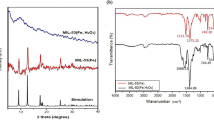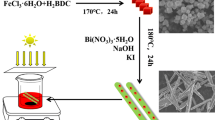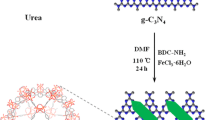Abstract
The work highlights the influence of cation doping on photocatalytic activity of MIL-53(Fe) in artificial light. The effect of intrinsic factors, viz. band-gap energy, electron conductivity and surface area, influencing photocatalysis was studied in detail w.r.t. the degradation of brilliant green dye both in the presence and in the absence of H2O2 as an electron scavenger. Reduction in band gap after cation doping was observed for Li+ (1.81 eV), Na+ (1.875 eV) and K+ (1.89 eV) when compared with the parent MIL-53(Fe) (1.95 eV). However, the photoactivity of the synthesized materials was in the following progression: MIL-53(Fe)(81.6%) > Li-MIL-53(Fe)(27.6%) > Na-MIL-53(Fe)(25.77%) > K-MIL-53(Fe) (24.18%). Effect of structural distortions in the octahedral backbone of MIL-53(Fe) due to cation doping was inferred as the plausible reason behind such behavior. The degree of electron delocalization and specific surface areas were found to be in the following progression: Na-MIL-53(Fe) (very low, 7.72 m2 g−1) < K-MIL-53(Fe) (low, 28.38 m2 g−1) < Li-MIL-53(Fe) (moderate, 42.14 m2 g−1) < MIL-53(Fe) (high, 51.71 m2 g−1), indicating that the intrinsic material properties have combinatorial influence on photocatalytic activity.

















Similar content being viewed by others
References
Fox MA, Dulay MT (1993) Heterogeneous photocatalysis. Chem Rev 93:341–357. https://doi.org/10.1021/cr00017a016
Ibhadon A, Fitzpatrick P (2013) Heterogeneous photocatalysis: recent advances and applications. Catalysts 3:189–218. https://doi.org/10.3390/catal3010189
Sahaym U, Norton MG (2008) Advances in the application of nanotechnology in enabling a ‘hydrogen economy’. J Mater Sci 43:5395–5429. https://doi.org/10.1007/s10853-008-2749-0
Li J, Sculley J, Zhou H (2012) Metal–organic frameworks for separations. Chem Rev 112:869–932. https://doi.org/10.1021/cr200190s
Tan K, Nijem N, Canepa P, Gong Q, Li J, Thonhauser T, Chabal YJ (2012) Stability and hydrolyzation of metal organic frameworks with paddle-wheel SBUs upon hydration. Chem Mater 24:3153–3167. https://doi.org/10.1021/cm301427w
Ai L, Li L, Zhang C, Fu J, Jiang J (2013) MIL-53(Fe): a metal–organic framework with intrinsic peroxidase-like catalytic activity for colorimetric biosensing. Chem Eur J 19:15105–15108. https://doi.org/10.1002/chem.201303051
Burtch NC, Jasuja H, Walton KS (2014) Water stability and adsorption in metal–organic frameworks. Chem Rev 114:10575–10612. https://doi.org/10.1021/cr5002589
Dias EM, Petit C (2015) Towards the use of metal–organic frameworks for water reuse: a review of the recent advances in the field of organic pollutants removal and degradation and the next steps in the field. J Mater Chem A 3:22484–22506. https://doi.org/10.1039/C5TA05440K
Xiao X, Tu S, Lu M, Zhong H, Zheng C, Zuo X, Nan J (2016) Discussion on the reaction mechanism of the photocatalytic degradation of organic contaminants from a viewpoint of semiconductor photo-induced electrocatalysis. Appl Catal B Environ 198:124–132. https://doi.org/10.1016/j.apcatb.2016.05.042
Liu K, Gao Y, Liu J, Wen Y, Zhao Y, Zhang K, Yu G (2016) Photoreactivity of metal–organic frameworks in aqueous solutions: metal dependence of reactive oxygen species production. Environ Sci Technol 50:3634–3640. https://doi.org/10.1021/acs.est.5b06019
Misho RH, Murad WA (1992) Band gap measurements in thin films of hematite Fe2O3, pyrite FeS2 and troilite FeS prepared by chemical spray pyrolysis. Sol Energy Mater Sol Cells 27:335–345. https://doi.org/10.1016/0927-0248(92)90095-7
Du J-J, Yuan Y-P, Sun J-X, Peng F-M, Jiang X, Qiu L-G, Xie A-J, Shen Y-H, Zhu J-F (2011) New photocatalysts based on MIL-53 metal–organic frameworks for the decolorization of methylene blue dye. J Hazard Mater 190:945–951. https://doi.org/10.1016/j.jhazmat.2011.04.029
Mahata P, Madras G, Natarajan S (2006) Novel photocatalysts for the decomposition of organic dyes based on metal–organic-framework compounds. J Phys Chem B 110:13759–13768. https://doi.org/10.1021/jp0622381
Ai L, Zhang C, Li L, Jiang J (2014) Iron terephthalate metal–organic framework: revealing the effective activation of hydrogen peroxide for the degradation of organic dye under visible light irradiation. Appl Catal B Environ 148–149:191–200. https://doi.org/10.1016/j.apcatb.2013.10.056
Gao Y, Li S, Li Y, Yao L, Zhang H (2017) Accelerated photocatalytic degradation of organic pollutant over metal–organic framework MIL-53(Fe) under visible LED light mediated by persulfate. Appl Catal B Environ 202:165–174. https://doi.org/10.1016/j.apcatb.2016.09.005
Mohaghegh N, Kamrani S, Tasviri M et al (2015) Nanoporous Ag2O photocatalysts based on copper terephthalate metal–organic frameworks. J Mater Sci 50:4536–4546. https://doi.org/10.1007/s10853-015-9003-3
Liang R, Jing F, Shen L, Qin N, Wu L (2015) MIL-53(Fe) as a highly efficient bifunctional photocatalyst for the simultaneous reduction of Cr(VI) and oxidation of dyes. J Hazard Mater 287:364–372. https://doi.org/10.1016/j.jhazmat.2015.01.048
Wang C, Du X, Li J, Guo X, Wang P, Zhang J (2016) Applied catalysis B: environmental photocatalytic Cr(VI) reduction in metal–organic frameworks. Appl Catal B Environ 193:198–216. https://doi.org/10.1016/j.apcatb.2016.04.030
Dhakshinamoorthy A, Asiri AM, García H (2016) Metal–organic framework (MOF) compounds: photocatalysts for redox reactions and solar fuel production. Angew Chem Int Ed 55:5414–5445. https://doi.org/10.1002/anie.201505581
Whitfield TR, Wang X, Liu L, Jacobson AJ (2005) Metal–organic frameworks based on iron oxide octahedral chains connected by benzenedicarboxylate dianions. Solid State Sci 7:1096–1103. https://doi.org/10.1016/j.solidstatesciences.2005.03.007
Lin C-K, Zhao D, Gao W-Y, Yang Z, Ye J, Xu T, Ge Q, Ma S, Liu D-J (2012) Tunability of band gaps in metal-organic frameworks. Inorg Chem 51:9039–9044. https://doi.org/10.1021/ic301189m
Samsudin EM, Abd Hamid SB (2017) Effect of band gap engineering in anionic-doped TiO2 photocatalyst. Appl Surf Sci 391:326–336. https://doi.org/10.1016/j.apsusc.2016.07.007
Shen L, Liang R, Wu L (2015) Strategies for engineering metal–organic frameworks as efficient photocatalysts, Cuihua Xuebao/Chinese. J Catal 36:2071–2088. https://doi.org/10.1016/S1872-2067(15)60984-6
Shin E, Jin S, Kim J, Chang SJ, Jun BH, Park KW, Hong J (2016) Preparation of K-doped TiO2 nanostructures by wet corrosion and their sunlight-driven photocatalytic performance. Appl Surf Sci 379:33–38. https://doi.org/10.1016/j.apsusc.2016.03.222
Hamden Z, Boufi S, Conceição DS, Ferraria AM, Do Rego AMB, Ferreira DP, Ferreira LFV, Bouattour S (2014) Li–N doped and codoped TiO2 thin films deposited by dip-coating: characterization and photocatalytic activity under halogen lamp. Appl Surf Sci 314:910–918. https://doi.org/10.1016/j.apsusc.2014.06.176
Liu R, Zhou X, Yang F, Yu Y (2014) Combination study of DFT calculation and experiment forphotocatalytic properties of S-doped anatase TiO2. Appl Surf Sci 319:50–59. https://doi.org/10.1016/j.apsusc.2014.07.132
Hu L, Deng G, Lu W, Pang S, Hu X (2017) Deposition of CdS nanoparticles on MIL-53(Fe) metal–organic framework with enhanced photocatalytic degradation of RhB under visible light irradiation. Appl Surf Sci 410:401–413. https://doi.org/10.1016/j.apsusc.2017.03.140
Serpone N (2006) Is the band gap of pristine TiO2 narrowed by anion- and cation-doping of titanium dioxide in second-generation photocatalysts? J Phys Chem B 110:24287–24293. https://doi.org/10.1021/jp065659r
Tosoni S, Di Valentin C, Pacchioni G (2014) Effect of alkali metals interstitial doping on structural and electronic properties of WO3. J Phys Chem C 118:3000–3006. https://doi.org/10.1021/jp4123387
Kato H, Kudo A (2001) Water splitting into H2 and O2 on alkali tantalate photocatalysts ATaO3 (A=Li, Na, and K). J Phys Chem B 105:4285–4292. https://doi.org/10.1021/jp004386b
Blasse G, Brixner LH (1989) Luminescence of perovskite-like niobates and tantalates. Mater Res Bull 24:363–366. https://doi.org/10.1016/0025-5408(89)90222-5
Blasse G, De Haart LGJ (1986) The nature of the luminescence of niobates MNbO3 (M=Li, Na, K). Mater Chem Phys 14:481–484. https://doi.org/10.1016/0254-0584(86)90050-7
Zhang C, Ai L, Jiang J (2015) Graphene hybridized photoactive iron terephthalate with enhanced photocatalytic activity for the degradation of rhodamine B under visible light. Ind Eng Chem Res 54:153–163. https://doi.org/10.1021/ie504111y
Zhang Y, Li G, Lu H, Lv Q, Sun Z (2014) Synthesis, characterization and photocatalytic properties of MIL-53(Fe)–graphene hybrid materials. RSC Adv 4:7594–7600. https://doi.org/10.1039/c3ra46706f
Férey G, Millange F, Morcrette M, Serre C, Doublet ML, Grenèche JM, Tarascon JM (2007) Mixed-valence Li/Fe-based metal–organic frameworks with both reversible redox and sorption properties. Angew Chemie Int Ed 46:3259–3263. https://doi.org/10.1002/anie.200605163
de Combarieu G, Hamelet S, Millange F, Morcrette M, Tarascon JM, Férey G, Walton RI (2009) In situ Fe XAFS of reversible lithium insertion in a flexible metal organic framework material. Electrochem Commun 11:1881–1884. https://doi.org/10.1016/j.elecom.2009.08.008
Combelles C, Ben Yahia M, Pedesseau L, Doublet M-L (2011) FeII/FeIII mixed-valence state induced by Li-insertion into the metal–organic-framework Mil53(Fe): a DFT + U study. J Power Sources 196:3426–3432. https://doi.org/10.1016/j.jpowsour.2010.08.065
Chaudhari NK, Chan Kim H, Son D, Yu J-S (2009) Easy synthesis and characterization of single-crystalline hexagonal prism-shaped hematite α-Fe2O3 in aqueous media. CrystEngComm 11:2264–2267. https://doi.org/10.1039/b910569g
Dong W, Liu X, Shi W, Huang Y (2015) Metal–organic framework MIL-53(Fe): facile microwave-assisted synthesis and use as a highly active peroxidase mimetic for glucose biosensing. RSC Adv 5:17451–17457. https://doi.org/10.1039/C4RA15840G
Yılmaz E, Sert E, Atalay FS (2016) Synthesis, characterization of a metal organic framework: MIL-53 (Fe) and adsorption mechanisms of methyl red onto MIL-53 (Fe). J Taiwan Inst Chem Eng 65:323–330. https://doi.org/10.1016/j.jtice.2016.05.028
Pu M, Ma Y, Wan J, Wang Y, Wang J, Brusseau ML (2017) Activation performance and mechanism of a novel heterogeneous persulfate catalyst: metal–organic framework MIL-53(Fe) with Fe II/Fe III mixed-valence coordinatively unsaturated iron center. Catal Sci Technol 7:1129–1140. https://doi.org/10.1039/C6CY02355J
Liang R, Shen L, Jing F, Qin N, Wu L (2015) Preparation of MIL-53(Fe)-reduced graphene oxide nanocomposites by a simple self-assembly strategy for increasing interfacial contact: efficient visible-light photocatalysts. ACS Appl Mater Interfaces 7:9507–9515. https://doi.org/10.1021/acsami.5b00682
Sherman DM, Waite TD (1985) Electronic spectra of Fe3+ oxides and oxide hydroxides in the near IR to near UV. Am Mineral 70:1262–1269
Taran MN, Dyar MD, Matsyuk SS (2007) Optical absorption study of natural garnets of almandine-skiagite composition showing intervalence Fe2+ + Fe3+ → Fe3+ + Fe2+ charge-transfer transition. Am Mineral 92:753–760. https://doi.org/10.2138/am.2007.2163
Yang Z, Xu X, Liang X, Lei C, Wei Y, He P, Lv B, Ma H, Lei Z (2016) MIL-53(Fe)-graphene nanocomposites: efficient visible-light photocatalysts for the selective oxidation of alcohols. Appl Catal B Environ 198:112–123. https://doi.org/10.1016/j.apcatb.2016.05.041
Bingham PA, Parker JM, Searle TM, Smith I (2007) Local structure and medium range ordering of tetrahedrally coordinated Fe3+ ions in alkali-alkaline earth-silica glasses. J Non-Cryst Solids 353:2479–2494. https://doi.org/10.1016/j.jnoncrysol.2007.03.017
Carl R, Gerlach S, Rüssel C (2007) The effect of composition on UV–vis–NIR spectra of iron doped glasses in the systems Na2O/MgO/SiO2 and Na2O/MgO/Al2O3/SiO2. J Non-Cryst Solids 353:244–249. https://doi.org/10.1016/j.jnoncrysol.2006.11.010
Brunschwig BS, Creutz C, Sutin N (2002) Optical transitions of symmetrical mixed-valence systems in the Class II–III transition regime. Chem Soc Rev 31:168–184. https://doi.org/10.1039/b008034i
Kobayashi H, Higuchi T, Kaizu Y, Osada H, Aoki M (1975) Electronic spectra of tetraphenylporphinatoiron (III) methoxide. Bull Chem Soc Jpn 48:3137–3141. http://www.journal.csj.jp.libproxy1.nus.edu.sg/doi/pdf/10.1246/bcsj.48.3137
Cannon RD, Montri L, Brown DB, Marshall KM, Elliottm CM (1984) Partial electron delocalization in a mixed-valence trinuclear iron (III)-iron (II) complex. J Am Chem Soc 307:2591–2594
Wang F, Liao Q, Xiang G, Pan S (2014) Thermal properties and FTIR spectra of K2O/Na2O iron borophosphate glasses. J Mol Struct 1060:176–181. https://doi.org/10.1016/j.molstruc.2013.12.049
Hanna L, Kucheryavy P, Liu C, Zhang X, Lockard JV (2017) Long-lived photoinduced charge separation in a trinuclear iron- µ3 -oxo-based metal–organic framework. J Phys Chem C 121:13570–13576. https://doi.org/10.1021/acs.jpcc.7b03936
Parthey M, Kaupp M (2014) Quantum-chemical insights into mixed-valence systems: within and beyond the Robin-Day scheme. Chem Soc Rev 43:5067–5088. https://doi.org/10.1039/c3cs60481k
Anpo M, Che M (1999) Applications of photoluminescence techniques to the characterization of solid surfaces in relation to adsorption, catalysis, and photocatalysis. In: Adv. Catal., pp 119–257. https://doi.org/10.1016/s0360-0564(08)60513-1
Cheng H, Wang J, Zhao Y, Han X (2014) Effect of phase composition, morphology, and specific surface area on the photocatalytic activity of TiO2 nanomaterials. RSC Adv 4:47031–47038. https://doi.org/10.1039/C4RA05509H
Noorjahan M, Durga Kumari V, Subrahmanyam M, Panda L (2005) Immobilized Fe(III)-HY: an efficient and stable photo-Fenton catalyst. Appl Catal B Environ 57:291–298. https://doi.org/10.1016/j.apcatb.2004.11.006
Wei X, Wu H, He G, Guan Y (2017) Efficient degradation of phenol using iron-montmorillonite as a Fenton catalyst: importance of visible light irradiation and intermediates. J Hazard Mater 321:408–416. https://doi.org/10.1016/j.jhazmat.2016.09.031
Wang J-L, Wang C, Lin W (2012) Metal–organic frameworks for light harvesting and photocatalysis. ACS Catal 2:2630–2640. https://doi.org/10.1021/cs3005874
Maier TM, Boese AD, Sauer J, Wende T, Fagiani M, Asmis KR (2014) The vibrational spectrum of FeO2+ isomers—theoretical benchmark and experiment. J Chem Phys 140:204–315
Acknowledgement
We gratefully acknowledge the financial support provided by Science and Engineering Research Board (Department of Science and Technology, Govt. of India) (Letter No. SB/FTP/ETA-419/2012).
Author information
Authors and Affiliations
Corresponding author
Electronic supplementary material
Below is the link to the electronic supplementary material.
Rights and permissions
About this article
Cite this article
George, P., Chaudhari, K. & Chowdhury, P. Influence of cation doping (Li+, Na+, K+) on photocatalytic activity of MIL-53(Fe). J Mater Sci 53, 11694–11714 (2018). https://doi.org/10.1007/s10853-018-2443-9
Received:
Accepted:
Published:
Issue Date:
DOI: https://doi.org/10.1007/s10853-018-2443-9




